Whatever a Spider Can
September 29, 2018
But in all seriousness, the game is incredibly well done and exceeded the very high expectations that I had built up for it. The foundation of which having been laid down almost fifteen years ago with Activision’s Spider-Man 2, developed by Treyarch Studios. A 2004 title loosely based off of Sam Raimi’s film of the same name. I absolutely loved the Spider-Man 2 movie and video game, the latter setting a new bar for quality Spider-Man experiences.
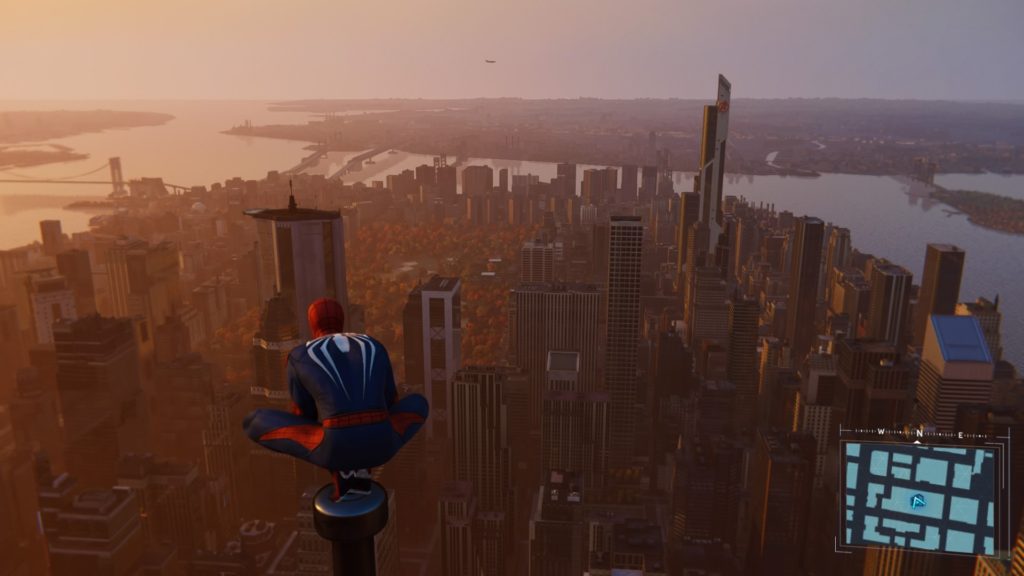
The city is yours to swing in!
But it hasn’t been all roses and rainbows for Spidey fans. Spider-Man has a long forty year history of mostly mediocre video game titles, starting with the first Marvel comics based video game, “Spider-Man” on the Atari 2600. From there it’s mostly variations on side scrolling adventures including team ups with Captain America and surprise boss appearances in Shinobi’s Revenge. Moving to the Sega Genesis’ Spider-Man vs. Kingpin, and it’s superior Sega CD counterpart, which was the first Spider-Man game to feature animated cutscenes and voice over work. Both games contained alternate endings involving MJ, vats of acid, and possible extreme versions of a skin peel treatment.
But then, in the chill of night, comes Spider-Man 2, like a streak of light, it arrives just in time. Setting the stage for future webhead games to come, introducing sandbox gameplay to the franchise, physics based swinging mechanics and Spidey Sense during combat. The Spidey Sense clearly leaving its mark outside of the Spider-Man game realm, counter attack warnings being incorporated into countless combat systems: enemies flashing red in Sleeping Dogs, dodge prompts above enemies when they are getting ready to attack in the Batman Arkham or Shadow of Mordor games, and even a small directional arrow pointing to the direction of an incoming attack in the latest God of War. All to allow combo stringing, dynamic combat, and to simulate a battlefield awareness that is inherent in the protagonist from each game.
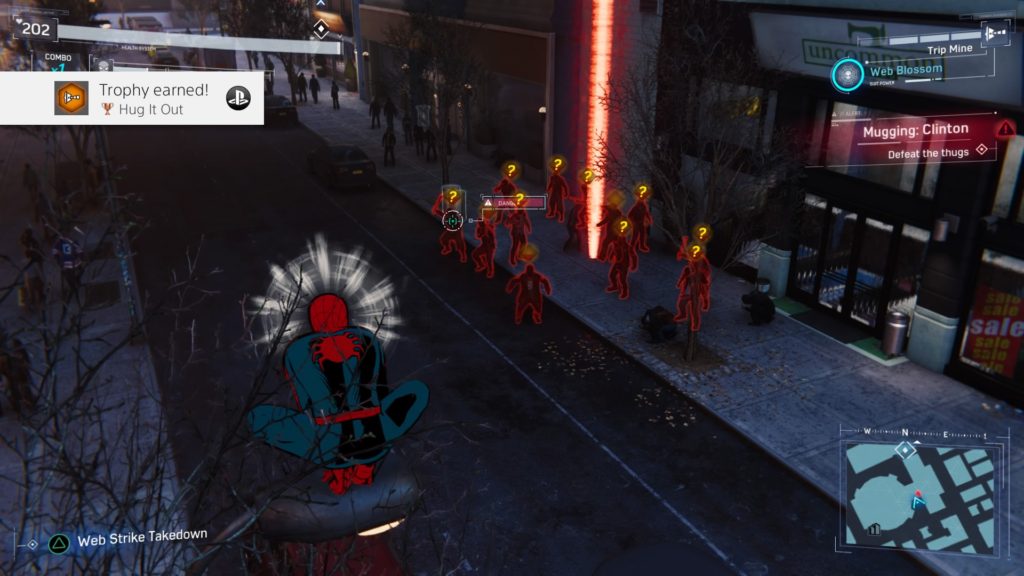
My Spider Sense is tingling!
But what Spider-Man 2 excelled at was allowing the player to really feel like Spider-Man while they were playing the game. And that all came from the web slinging. James Fristrom, a technical director and designer at Treyarch, was pivotal in creating the system. He started prototyping the system during work on Spider-Man, the 2002 predecessor to Spider-Man 2. Due to the amount of development time already put into Spider-Man, and the rough state of the prototype, the web slinging was shelved and implemented in Spider-Man 2, being continuously tweaked and refined right up until launch date for the game.
And Marvel’s Spider-Man picks it right back up, making zipping around New York smooth, intuitive and incredibly addicting. Shoot a web out with the R2 shoulder button, hit the X button to gain height or speed, depending where you are in the arc of the swing. Couple that with quick web zips to help you bridge gaps where you might not have any buildings to attach web too, and point launches that allow you to target a specific point like a ledge, street light, or the top of a radio tower so you can launch yourself off of it to build momentum for your next swing, and you’ll have no trouble swinging after cars full of gunmen or chasing down supervillains in the streets.
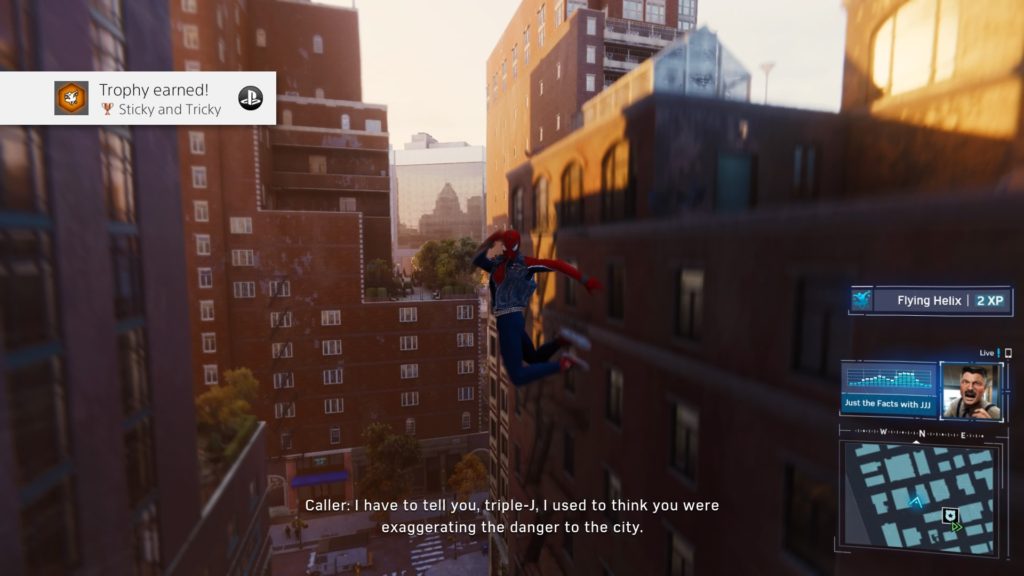
For those about to swing, WE SALUUUUTE YOOUUU!!
Once you do catch the bad guys though, they sure as hell won’t be going down without a fight! The combat is the second part of three that help achieve full Spidey immersion. Your Spider Sense returns, and this time you have plenty of gadgets to utilize. I’m a huge fan of the Arkham game series, especially Arkham City, and it’s cool to see the kind of cyclical influences these old and new combat systems have culminated in.

THWIP THWIP
The majority of Spider-Man’s gadgets are web shooter based, which is great and obviously makes sense, offering you different types of webbing other than your standard web shooters. Like the Impact Webbing that can blast guys backwards, webbing them to walls or cars with one hit. Or the Electric Web that does exactly what it sounds like it would do. Gadgets can make an impossibly uneven fight tip well in Spidey’s favour if used correctly, and are where a lot of the depth of combat comes from. The problem with that is, changing between gadgets can be interruptive. You have a quick change between your currently equipped gadget and the last gadget that you used by double tapping L1, but if you want to change to one of the possible eight that you can unlock, you have to bring up a radial menu that slows combat right down, but doesn’t stop it completely. Which I find can break the flow of combat, pulling you out of the experience, since when you drop out of the menu, it’s easy to get blindsided by a hit that was coming right before you popped up the menu.
That’s how the normal, low level thug combat works. The boss fights are their own beast, mainly consisting of dodging the boss’s attacks until there is an opening or quick time event trigger. Each fight does have specific variations based on the villian, which I won’t spoil here. This makes the boss encounters more cinematic, rather than interactive, but I still really enjoyed them all. Being a fan of the villains and enjoying just seeing them on screen personally helped bolster up any failings the fights may have had, so take it with a grain and all that.
The final piece of the Spidey emulation trifecta is the voice acting and writing for the game. It really is one of the standout parts of the whole playthrough. Everytime you interact with another character, as Spider-Man or as Peter Parker, you really get the feeling of duality that Peter exists with, and experience first hand just how tragically linked his life is with his heroic alter ego. Again, without spoiling anything, there is a main interaction with another character that Peter continually has that runs the gambit from heartwarmingly endearing to devastatingly harrowing. To balance out the drama, are the quips! Oh, the quips. There are plenty of them, as is typical for Spidey, and they are great. It’s readily apparent that a lot of love went into crafting some of the smaller details in this game. Best example of that is Spider-Man dialogue being recorded twice, giving you a more exasperated and exerted delivery if you’re out web slinging around the city.
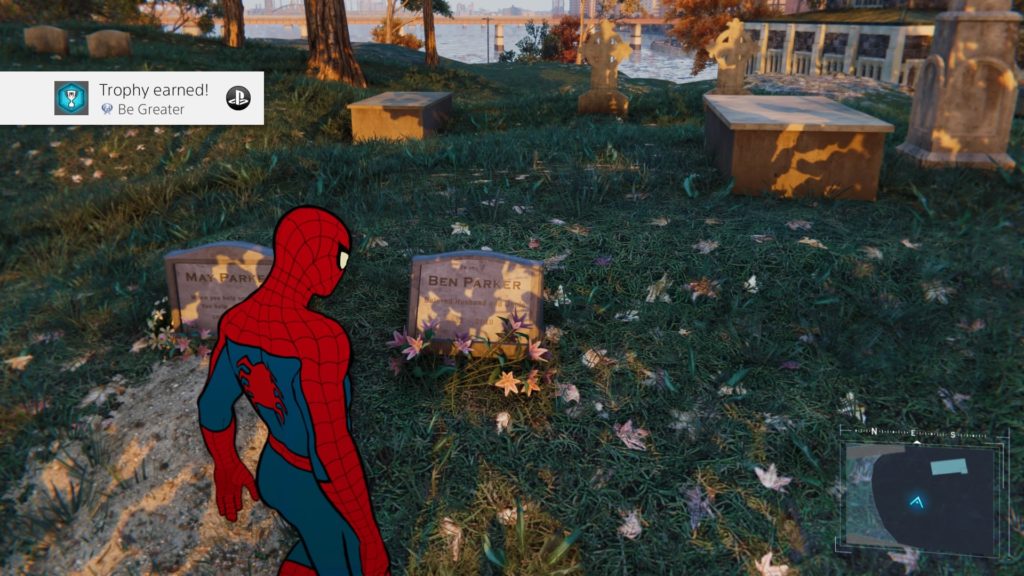
With great power. . .
I really like the space this video game universe exists in. Being its own thing, mostly staying true to character origins, with some changes to give it a bit of a refreshing Elseworlds vibe, yet still familiar enough to not be off putting to a hardcore fan, or confuse a less versed one.
Like any open world game, there are a metric fuckton of collectibles and side missions around the city. Ones that you will definitely want to get and complete, since they’re what you use to get the unlockables in the game. Which consist of different Spider-Man suits that come with a suit power, gadget unlocks and upgrades, and combat mods. Each unlock requiring a certain number of a specific type of token, often multiple types. Like a new suit may require five Crime tokens and six Landmark tokens. The former you earn from stopping crimes, and the latter you earn by photographing certain landmarks around the city.

I hear the weight lifting facility is really good at least

Yo Tony! TONY!
In addition to these unlockables, you have a skill tree that you earn experience points for as you level up. The tree is divided into three main branches: stealth, combat and web slinging. Each offering new moves and abilities to use as the main RPG like character progression that is found in many open world games.
The unlockable system is super smart, giving you lots of incentive to complete the side missions other than just completing them for completion’s sake. Most side missions, like combat ones, have conditions you can meet to earn extra tokens. Like completing a specific combat maneuver a certain amount of times in an encounter.
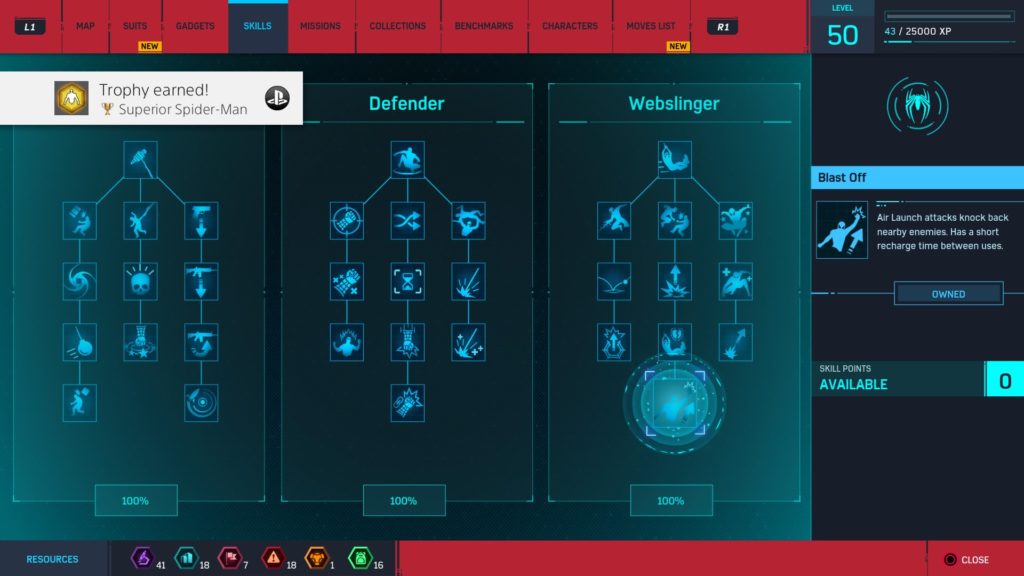
I got SKILZZ
I found that there was a large abundance of experience points and most tokens. I easily hit max level well before the end of the game, and I Patinum trophied the game, so I got all of the unlocks, completed all side missions, etc. Strangely though, there was one type of token, the Challenge token, which was a real pain in the ass to get. You need almost the max number that you can earn, and some of the challenges definitely live up to their moniker. Luckily, these were mostly used on the combat mods, and not something way more fun, like the different Spidey costumes you can unlock.

What should I wear today? I can never decide!
These are actually progression based, same with the gadgets, and gadget power level unlocks. Before you can even look up how many of which tokens you need to unlock one of them, you will need to progress to a certain point in the main story. This seems to be an attempt at controlling the pacing of the game, which it does achieve. A huge problem with most open world games is that there always ends up being too much stuff, too far apart. Creating large gaps between main story beats, depending on playstyle approach.
Speaking of open world, I have mixed feelings on how well this game pulls it off. It’s difficult to really pin down why it feels different than other sandbox games. On the positive side, the controlled pacing and story related unlockables creates a great flow to the gameplay. It always seems to keep the momentum going for the majority of it. The main purpose of the city is to serve as a vehicle for the web slinging, which is both a positive and a negative. It greatly enhances the feeling of being Spider-Man, as stated above, but the web slinging means you aren’t really interacting with the city or the city’s inhabitants. The friendly neighborhood Spider-Man is a bit anti-social. The depth of gameplay doesn’t really come from the open world aspect, like a Grand Theft Auto, or God of War to a lesser extent; where you have game systems being implemented within the open world that allow you to realize the scope and grandeur of playing within that sandbox. In Spider-Man, you have the opposite. The open world concept is being applied to the game systems to enhance the way you use and experience them. Again, serving the purpose of emulating the Spider-Man experience, which is the main focus the developers had when creating this game.
Which brings me to the biggest negative for this game, and that is the “slice of life” sequences that occur throughout. These are forced stealth sequences where you play as characters other than Spider-Man. They aren’t particularly difficult, or very long, but they do break up the Spider-Man immersion that the game is trying to employ. So when I say that they are the biggest negative, I mean that only in relative terms to the rest of the game. Two of these sequences in particular were actually really fun, one of which you get to work with Spidey, distracting bad guys and luring them to spots where you can direct Spider-Man to stealthily web them up and knock them out. They just seem like an odd choice for the game, especially when the dialogue in the cutscenes is so good, it is more than enough to get you to connect with the characters and understand their motivations in the short amount of time you get to spend with them.
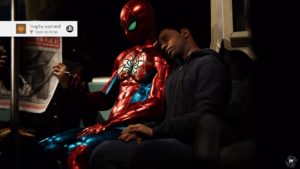
Quick travel Subway rides, making friends
Final thoughts time. I’m so incredibly happy with how this game turned out. The web slinging is awesome, the combat is fun and challenging, albeit ridiculously difficult in some encounters with multiple gunmen, and the collectibles and side missions expertly incentivized to complete, maximizing the bang for your buck you get for the full retail price. If this hadn’t released in a year with God of War in April and Red Dead Redemption 2 in October, this would 100% be 2018 game of the year material. That being said, if you are at all on the fence about picking it up, or you’ve always wondered what it’s like being Peter Parker/Spider-Man and catching thieves just like flies, go pick this up. Get it, love it, and thank me later.
L.


